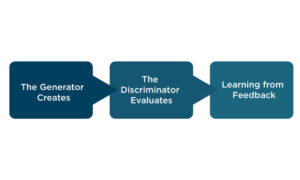In machine learning, there are many exciting techniques that help computers learn from data. One of these techniques is known as Generative Adversarial Networks (GAN). They have two parts that compete against each other to create realistic content. Let’s understand it in simple terms!
What are GANs?
A generative adversarial network (GAN) is a machine learning model that creates new data such as images, music, or even text, that resembles the given training dataset. According to report published in April 2024, the global GAN market size is expected to reach at136.7 billion in 2027 with CAGR of 36.7%.
Components of GAN
GAN performs these tasks by using two components known as generator and discriminator.
The Generator: The generator is like an artist, it creates new data that is similar to real data. For example, if we want to create pictures of cats, the generator will try to create images that look like real cats. It will learn to produce more realistic images through training.
The Discriminator: The discriminator is like a critic, it looks at the data and decides whether it is real (from the training set) or fake (created by the generator). It checks whether the images are genuine, or if they were created by the generator. As discriminator sees more examples to check whether it is fake or real, it starts giving better results for same.
How Do GANs Work?
GANs work through a process of competition between the generator and the discriminator. Let us see how it works:
The Generator Creates: The generator makes a new image (or other types of data) based on what it has learned.
The Discriminator Evaluates: The discriminator examines this new image and compares it to real images. It gives feedback on whether the image is real or fake.
Learning from Feedback: The generator and the discriminator learn from the feedback. Through feedback, the generator improves its ability to create realistic images, while the discriminator gets better at spotting fake images.
The competition keeps going until the generator makes pictures that look so real that the discriminator is unable to tell the difference between real and fake.
Why are GANs Important?
GAN are important as they create high-quality data that is used in various applications, such as:
- Art and Creativity: Artists can use GANs to make new art or music. Some projects have even used GANs to generate paintings that appear to be like human art. It mixes creativity with technology.
- Video Games: Game developers can generate realistic graphics and environments. GANs create realistic characters and landscapes, making games more immersive and visually attractive.
- Medical Imaging: In healthcare, GANs can help create synthetic medical images for training purposes. This can be helpful for teaching medical professionals without compromising the privacy of the patient.
- Fashion and Design: Fashion designers can use GANs to create new clothing designs and patterns. This helps them to think of new ideas faster and makes the design process quicker.
- Text and Language Generation: GANs can also be applied to text generation. For instance, they can help create realistic dialogues for virtual characters in movies or video games.
Challenges and Limitations
While GANs are powerful, they have few disadvantages:
- Training Instability
Training GANs can be tricky. Sometimes the generator and discriminator may not balance well, leading to poor results. Finding the right settings for training is crucial.
- Mode Collapse
When generator creates limited variety of outputs, mode collapse occurs. Instead of generating diverse images, it might only create a few similar ones, which reduces the effectiveness of the model.
- Ethical Concerns
The ability of GANs to make realistic fake images raises ethical concerns. For example, deepfakes, videos that manipulate reality can be misused. It is important to use GAN technology in a responsible manner.
Future of GANs
As technology advances, GANs will continue to give better results. Researchers are focusing on making them more stable and finding new uses. GAN can be used in areas like virtual reality, personalized content creation, and even scientific research widely.
Summing Up!
Generative Adversarial Networks are an interesting part of machine learning. It consists of a generator and a discriminator. Both of these components work together to create new and realistic content. Learning about GANs brings exciting opportunities for the future of artificial intelligence! As we explore their capabilities, it is important to approach this technology with both enthusiasm and caution, ensuring we harness its power for positive and creative outcomes.
You May Also Like to Read:
An Overview of Machine Learning. What can machine learning be used for?



